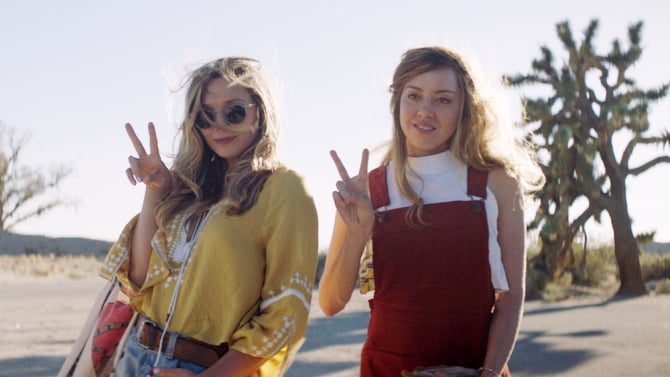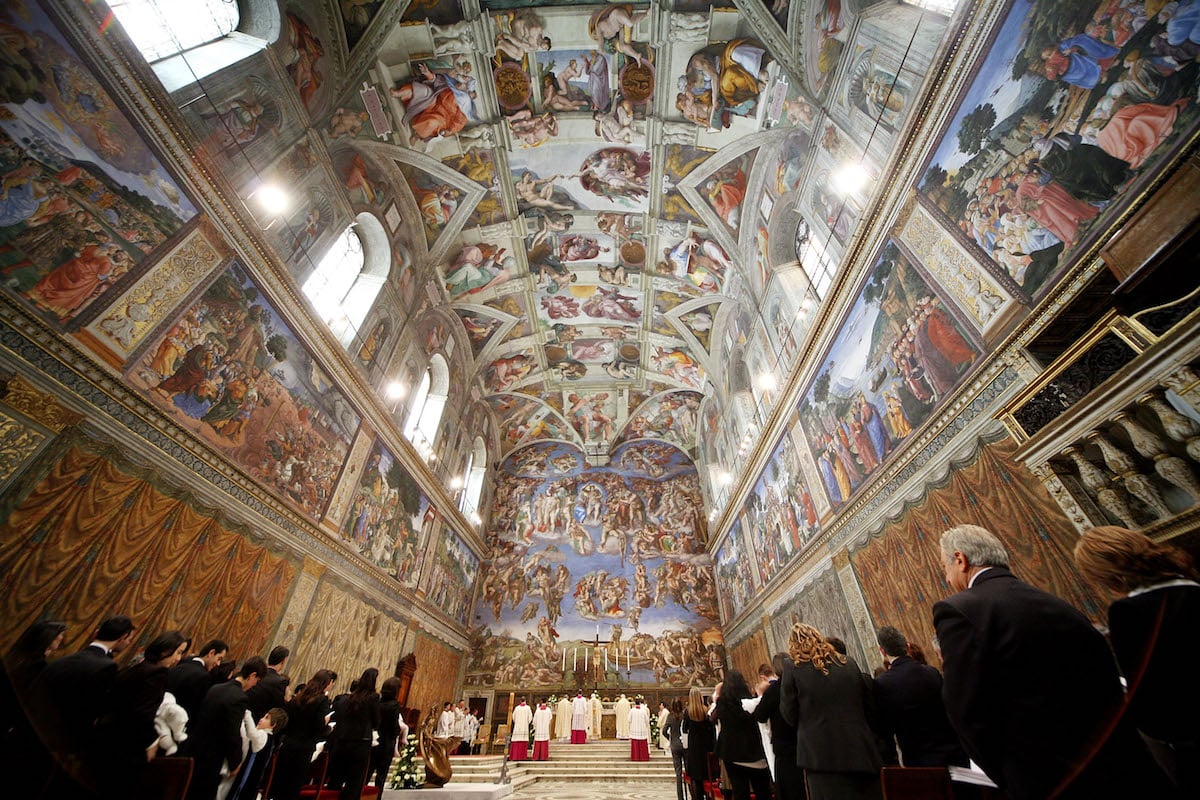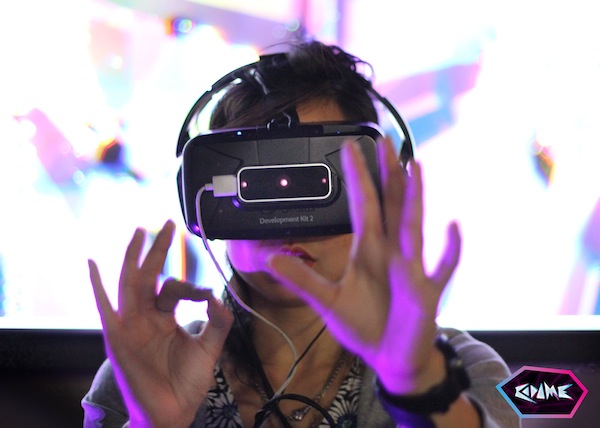

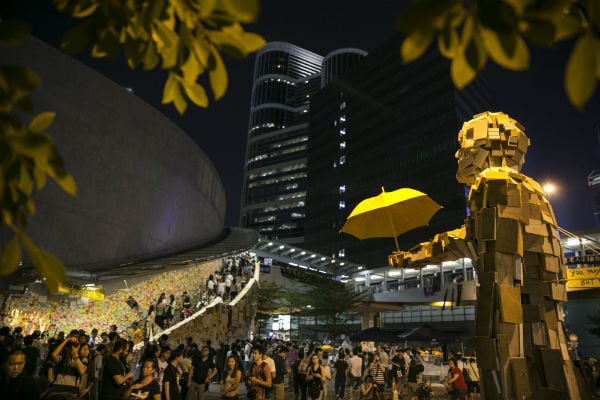
Hong Kong’s Umbrella Man sculpture, by the artist known as Milk, has become a symbol of Occupy Central in Hong Kong.
1. “Bring Back the Nerdocracy,” Paddy Johnson and Corinna Kirsch, ArtFCity
This one gives some material for a history of the recent Internet and art blogosphere, from engaged participants.
Key line: “The tide has changed for blog nerds. Tech is cool, but text is not.”
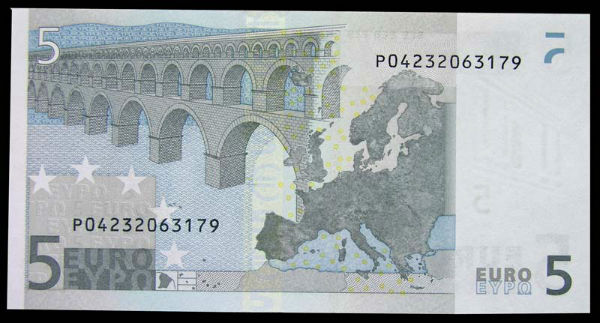
The €5 note, with its fictional Roman aqueduct.
2. “How a United Europe Defused Its Culture and Divided Its People,” Yanis Varoufakis, the Brooklyn Rail
Particularly in light of the recent triumph of the anti-austerity Syriza party in Greece, there’s a real gravity to Varoufakis’s reflections on how the EU’s unresolved economic contradictions find themselves expressed through culture.
Key line: “A continent replete with cultural treasures has, unbelievably, chosen to adorn its freshly minted common notes with none of these treasures. Why? Because bureaucrats wanted to print nothing ‘dangerous’ on the new money. Even if one knew nothing of economics, and of the Eurozone’s hideous architecture, one glimpse of the cultural desert on the euro notes might have sufficed to suggest what would transpire.”
3. “Image Conscious,” Jason Farago, Artforum.com
It gives me a little twinge of unearned pride to think that one of the best essays written in the wake of the recent horrifying events at Charlie Hebdo in Paris was from an art critic, with Farago expertly explaining the intricacies of the weekly paper’s satire, largely lost in the tidal wave of other post-attack think pieces.
Key line: “Whether second degré humor is possible in such circumstances is not clear. Charlie Hebdo’s ’68-era mockery may have no future in such an unequal society. But if you really want to call out racist cartoons, you would do better to start with Tintin and Astérix.”
4. “Losing Interest,” Shumon Basar, Art Papers
Basar (co-author of the upcoming The Age of Earthquakes with Hans Ulrich Obrist and Douglas Coupland) pens a tart little anti-manifesto for Art Papers‘s special issue on design, a personal narrative that is also a diagnosis of the ills of theory.
Key line: “I realized that this epistemological generosity served by architecture’s academia is not from selfless reasons. It is partly born from a kind of ontological insecurity that goes back to the man overseeing the building of the medieval cathedral: ‘What exactly do I know and what exactly do I do that makes me unlike anything or anyone else?’”
5. “Right or Wrong? Is It Time to Rethink Copyright Legislation?,” Wim Pijbes, Gilane Tawadros, Philippa Malas, Thomas Marks, Peyton Skipwith, Apollo
Museum administrators, lawyers, and editors debate the thorny issue of artist copyright in the pages of Britain’s Apollo magazine, a pithy reminder about all the unresolved debates looming large over art today.
Key line: (from Peyton Skipwith, the director of the Edward Bawden estate): “Copyright on the whole seems to be understood better by publishers and product manufacturers than by museum curators, who often claim copyright on objects long after it has expired or where they merely control access rights to the photographic image.”
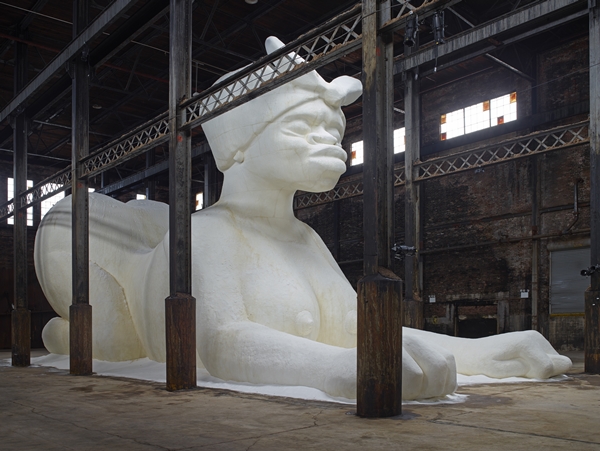
Kara Walker, A Subtlety (2014).
Photo: Jason Wyche, Courtesy Creative Time.
6. “The Sharp White Background,” Naomi Beckwith, Frieze
MCA Chicago curator Beckwith brings some theoretical and historical perspective to last year’s bruising debates over race in the art industry.
Key line: “We lack a language to discuss the very art-world structures that prevent the development of more useful terms about race or other minority identities.”
7. “The State of Hong Kong’s Art Scene,” Barbara Pollack, ArtNews
With last year’s “Umbrella Movement” in Hong Kong still simmering, China expert Pollock gathered some great quotes about how the professional art scene was reacting to (or in the case of the more moneyed sectors, not reacting to) the specter of social change.
Key line: (from Oscar Ho Hing-kay, founding director of Asia Art Archive) “What’s happening now with this Umbrella Movement is that you start to see among the younger people a collective obsession with Hong Kong, a Hong Kong identity, which is very unusual for Hong Kong.”
8. “Is There a Formula for Free Admission?,” Nina Simon, Museum 2.0
Nina Simon’s blog is a great resource if you’re looking for clean, forward-thinking insight on contemporary museum administration. I could pick any number of her posts, but this one is exemplary in the way it targets a problem in the spirit summed up by its opening line (see below), and then actually goes on to deliver by answering the question it asks.
Key line: “There are plenty of great arguments out there for WHY to make museums free. But HOW do you do it?”

Image from Art+Tech: Virtual Reality, November 2014.
Photo: Courtesy Codame
9. “Up in the AIR: How Will Tech Residencies Reshape Bay Area Art?,” Ceci Moss, Rhizome.org
This is a useful look at the increasing interest in sponsoring artists by Silicon Valley giants like Autodesk and Facebook, and the subtle ideologies that shape—and pervert—the resulting slew of residencies.
Key line: “If the art object on display in the corporate lobby is a symbol of accumulated wealth and financial stability, the artist-in-residence studio or workshop in the tech company becomes a showroom of ingenuity and creativity.”
10. “Why Isn’t Art Funny More Often?,” Whitney Kimball, Vice.com
I liked this mainly because I ask myself this question. And because the subjects of this interview—Guy Richards Smit (whose comic Grossmalerman artist-persona got a workout recently at Pierogi), Jibz Cameron (of the off-the-wall and most excellent Dynasty Handbag, just seen in “American Realness”), and Jamie Warren (known for her off-the-wall traveling pageants)—are deserving of celebration, and give me the excuse to embed the video above!
Key line: “If Glenn Lowry walks into a bar, it is to drink or to network; he does not bring a rabbi with him.”
For more articles by Ben Davis, see Loris Gréaud Smashes the Mold for Museum Shows and 30 Art-Writing Clichés to Ditch in the New Year.
Follow Artnet News on Facebook:
Want to stay ahead of the art world? Subscribe to our newsletter to get the breaking news, eye-opening interviews, and incisive critical takes that drive the conversation forward.



